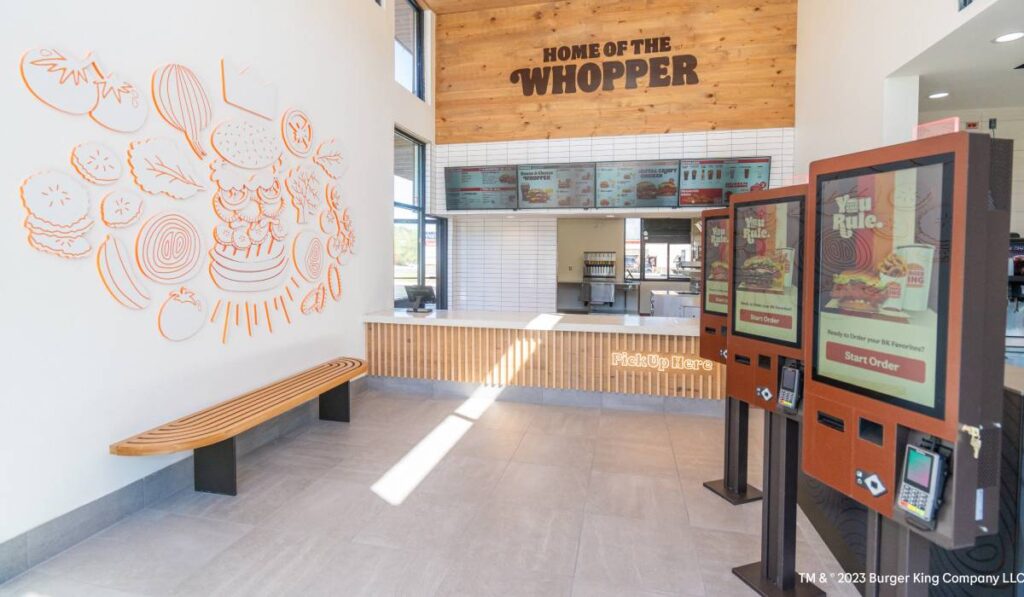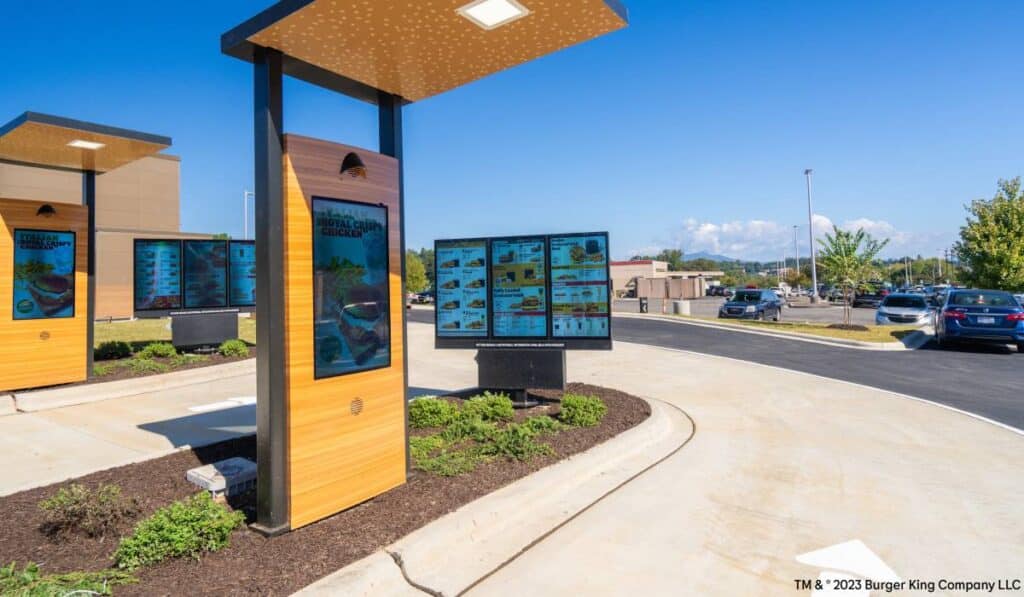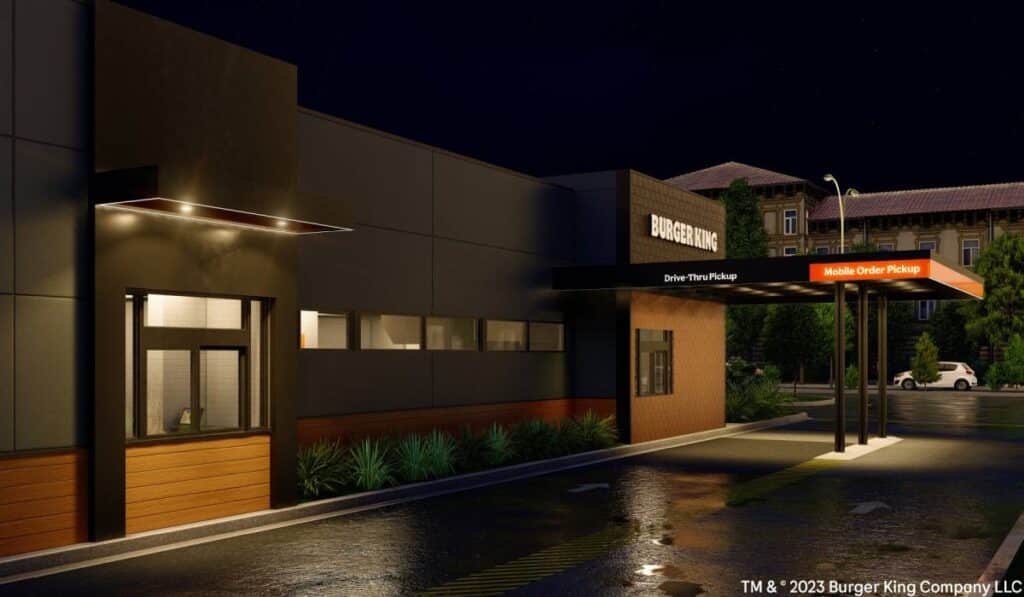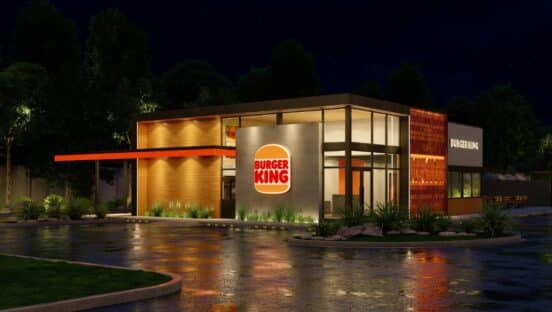Year 2 of Burger King’s “Reclaim the Flame” promises a fresh marketing tilt and no shortage of operational and technical threads. But the gist of the chain’s progress, roughly 13 months after the $400 million plan was launched, isn’t complex, North America president Tom Curtis says. “The last year, they hoped they could invest,” Curtis says of franchisees. “This year, they know they can invest, because things are getting better.”
Curtis spoke to QSR fresh off the brand’s annual franchisee convention. One thing the company flashed on screen for operators was a next-act prototype it feels will be well worth contributing toward.
The prototype, labeled “Sizzle,” was designed not only for the evolution of Burger King, but for where the consumer has taken quick service as a whole. Two have come to market—in Marion, North Carolina, and Las Vegas. The Marion store, located about 20 minutes outside of Blue Ridge Mountain-nestled Asheville, was built by Burger King’s largest franchisee, Carrols Restaurant Group. In line with Curtis’ comment, Carrols in August reported “one of the best quarters in the company’s 63-year history,” according to CEO Deb Derby. Carrols’ stock popped double-digits as same-store sales climbed 10.4 percent and restaurant-level profit margins hiked 620 basis points to 14 percent of the business. Adjusted EBITDA was 9.1 percent of sales ($44.3 million) a year after margin was 3.4 percent.
READ MORE: For Burger King, a Reset, then a Revival
And, Curtis says, Carrols wants to do all of their go-forward openings under the Sizzle banner. With Marion, the build actually sits next to the old restaurant, which hasn’t been knocked down yet, providing a stark juxtaposition of where Burger King is headed and where it came from.
“Sizzle” is a warm and inviting décor package, Curtis says, where guests and operators instantly feel the modern take. Yet the real unlock comes with guest experience. The format allows new modes like kiosk and in-store mobile order and pickup, as well as mobile order and pickup at the drive-thru. Those are defined clearly “so the guest gets the same consistent experience every time they come to one of our restaurants,” Curtis says. The back of the house also cut down on steps for employees and flowed layout toward more efficient service.
The Marion Burger King boasts 40 seats, but franchisees can pick 40, 60, or 80 depending on need. Typically speaking, the box cuts about 200 square feet from traditional builds as an increasing number of restaurants favor off-premises avenues over dine-in capacity.
Curtis says the brand will “probably” have 14 additional prototypes completed in 2023. Broadly, though, there are more scrape and rebuilds scheduled for 2024 than there were in the five years prior, he adds. “I think, in general, this is not going to be a push for us with the franchisee because it’s a cost parity and because it’s warm and inviting and because it’s operationally friendly,” Curtis says. “So we think it’s going to be a pull.”
In other words, rather than corporate having to sell Sizzle’s merits, he expects more franchisees to fall into Carrols’ camp. Ultimately, it will become required as the brand’s remodel or new-store option, but actually refacing or rebuilding to the image won’t be mandatory, Curtis says.











However, it is likely “Sizzle” will spread quickly. Included in Burger King’s $400 million outline is $200 million toward store designs. Previously, north of 75 percent of U.S. restaurants committed to full remodels or scrapes and rebuilds (some 300–350 are slated to remodel this year). The brand last quarter said it’s spent $9 million of an earmarked $50 million on refreshes thus far, things like better toasters and broilers.
In the $200 million “Royal Reset,” remodel royalty credit is recognized as contra-revenue in “franchise and property revenues” over a period of up to 20 years. Franchisee elected royalty rate increases apply to all restaurant level sales and benefit “franchise and property revenues.”
So essentially, franchisees receive a higher percentage contribution for a higher-scope project. In turn, expect a lot of scrape and rebuilds as Burger King aims at a long-term transformation over a quick fix. “At some point, we’ll tell them that’s the only one that’s available,” Curtis says of Sizzle. “They need to get double drive-thrus in so we can accommodate the digital experience. We need to get the footprint of the interior design so that people can come in and order on kiosks. And we need to have that designated space and place for people who want to mobile order and just come in and swoop up their food—they need to be able to that. We also have to have the technology to support that.”
Burger King’s previous store update—Garden Grill—first circulated internationally in 2011. The company said, by the end of next year, nearly half of domestic stores would have the Sizzle or Garden Grill look. Both will be in development.
Curtis says in a good number of Garden Grill units, if the foundation is solid, the conversion is not necessary to knock it down. But the future goal, as noted, will be to only offer Sizzle as the available package for operators.
Burger King worked in lockstep with franchisees to create “Sizzle.” It took more than a year of ideation compared to the four-to-six-month windows Curtis experienced at past shops. “Everybody that does it is excited about it, because franchisees helped us on it,” he says. “Obviously, we had to watch the costs so the costs are right in line with our other models and what we’ve done in the past. So on all fronts, there’s a lot of interest in putting them up. And I think it might be an accelerator as well. The Reclaim the Flame investment accelerated the remodel pace over the next couple of years. But I think just having this exciting format and design is going to probably accelerate things as well.”
Speaking wider, Curtis says the theme of this year’s conference was twofold—express and accentuate progress, but also reiterate it’s merely a good start. Burger King reported Q2 same-store sales growth of 8.3 percent in U.S. after seeing 8.7 percent growth in the first quarter.
The average four-wall EBITDA of “A” Burger King operators, management also shared, was over 65 percent higher than the system average last year.
Still, much of the top-line expansion, as echoed throughout the sector these days, came from higher spend over positive guest counts. CEO Josh Kobza told investors in August the brand was “still not in positive [traffic] territory,” adding it represented “one of the most significant near-term opportunities.”
“Everybody here saw that hey, the vast majority of work still lies ahead of us,” Curtis says of the convention.
The summary statement, he adds, was Burger King, over the last decade or so, ceded ground to competitors and struggled to generate profitable stores. “And we’ve started to turn that around,” Curtis says.
To date, it’s been a project structured around four pillars—marketing, restaurant execution, restaurant image, and franchisee success. While those remain the same headed into Year 2, there have been some “adjustments on the edges,” Curtis says, as Burger King works to stay consistent and drive momentum.
In Q2, the company spent roughly $12 million of $150 million set aside for advertising and digital goals. Overall, the brand spent $12 million in the period against its “Fuel the Flame” investment, including $10 million for advertising, and $11 million for “Royal Reset.” As of June 30, RBI funded $32 million for Fuel the Flame and $35 million on Royal Reset.
The brand’s “King” mascot made an appearance at the convention. But it was the opposite of a re-introduction. “It was more about, here’s what we’re not going to do,” Curtis says.
The “King” hasn’t shown up in ads or materials for over a year now. Instead, Burger King focused on core equities last year and into 2023, especially in regard to the Whopper (think viral jingle). Although that directive was the correct lane, Curtis says, the experience did illuminate what should follow. “The Whopper is a flagship product and talking about it was good and right and it did ignite some new interest in younger guests,” Curtis says. “Certainly, it reassured our legacy guests of why they come to Burger King. But the reason, the why around the Whopper, is not the Whopper sandwich, but it’s a flame-grilled burger that’s got a smoky backyard barbecue flavor that no other [quick-service restaurant] has.”
When Curtis arrived at Burger King in mid-May 2021 after 35 years at Domino’s, he admits he wasn’t sure what to do with the Whopper. It was an iconic, sturdy product that didn’t need refinement. Yet he’s come to realize the smoky, backyard flavor and barbecue profile is where the story can be amplified. And that’s all across Burger King. “I think the pivot going forward is going to be not first with the Whopper and then, ‘oh yeah, it’s flame grilled.’ But Burger King is flame grilled and we have a flagship Whopper that’s a great expression of that.”
“You’ll really feel, when you see our marketing communications, that smoky backyard flavor come through your television screen.”
Innovations around the Whopper, like the Ghost and Spider-Verse activations (red thanks to paprika in the bun), helped drive trial and rebuild Burger King’s consumer base. Those will continue. And so will the continued messaging around customization—“You Rule”—that reframed the chain’s “Have It Your Way” tagline.
A good example, Curtis shares, was the brand’s recent “Have-sies” introduction, where customers can get fries and onion rings in the same container with combos. “We’ll be on-air with those [messages] over the next two to eight weeks depending on which campaign it is,” Curtis says.
Overall, he continues, the feeling among store leaders, employees, and operators reflects what Curtis saw at Domino’s when the brand reversed course years ago. Over the stretch of a decade, he watched “a brand become cool and relevant and exciting,” Curtis says. “And watching the chemistry and the culture that creates internally with the franchisees and the team members and the corporate teams, I can clearly see now Step 1 of that happening at Burger King. … We’ve got to be intent and thoughtful about every step. And so, we’re more excited, more fired up, than we’ve ever been. But we’re still not overconfident. This isn’t a layup; it’s a 3-point shot.”








